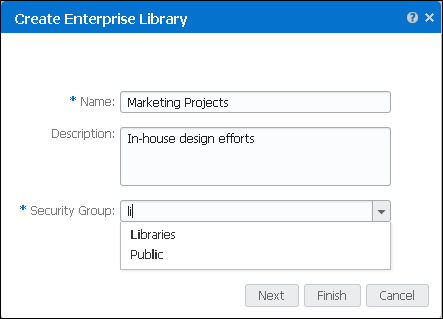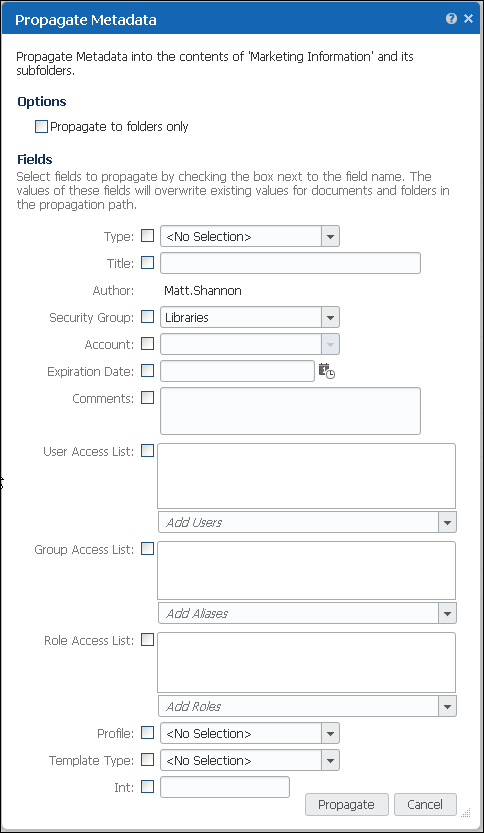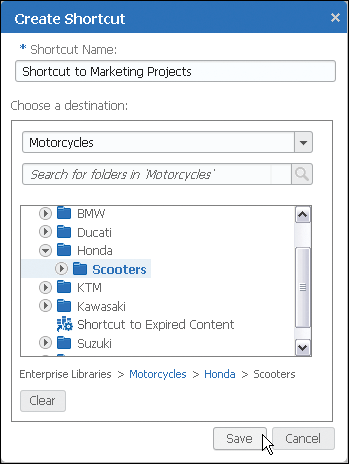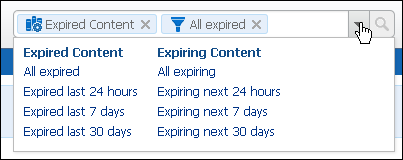13 Working with Libraries
Libraries are used to organize and control access to documents, as well as associate the appropriate metadata with documents. This chapter describes how to create, secure, modify, and delete libraries. It has the following topics:
13.1 About Document Libraries
Libraries and folders provide the context of a document, helping to determine what metadata fields are associated with a document and in some cases assigning values to the metadata automatically. Organizing documents in libraries helps to ensure documents are secure, can be shared, and are easily found by yourself and others. For detailed information on Libraries and Folders, see Chapter 5 and Chapter 6.
There are two types of libraries:
-
Enterprise Libraries, created by individuals to provide flexible security and comprehensive document management used by an entire organization.
-
System Libraries, created and managed by Oracle WebCenter Content to organize documents that are in one of the following system processes:
-
Checked-Out Content (content locked for editing.)
-
Expired Content (documents that are no longer actively managed by Oracle WebCenter Content. Expired content can be filtered to also display documents set to expire within a specified date range.)
-
Work In Progress (documents that are in a conversion or indexing process and not yet ready for release.)
System libraries offer the ability to quickly find documents that are not currently released. You cannot upload documents to a system library.
-
Note:
The permissions you have to a library determine the options available to you when working with that library.
13.2 Creating an Enterprise Library
Enterprise libraries provide flexible security and comprehensive document management used by an entire organization. To create an enterprise library:
-
Click Browse on the Find Documents page to display a list of all libraries.
-
Click Create Library.
-
Enter a unique name and description for the enterprise library on the Create Enterprise Library page and click OK.
Note:
It is a good idea to select a unique name for any enterprise library that you create as in most cases you cannot have multiple enterprise libraries with the same name.
-
Enter a security group for a library. For information on security groups, see Section 4.5.
Important:
To use an access control list on a document uploaded to the library, the security group selected for the library must support access control lists, or the added security does not work. If you are uncertain if the security group you are using supports access control lists, check with your system administrator.
-
Click Finish if done, or continue to set additional options if they are enabled.
-
If configured to use Accounts, click Next to optionally select an account for additional security. Use of accounts in Oracle WebCenter Content is optional and determined by your system administrator. You can begin typing to filter the list of any available accounts. For information on accounts, see Section 4.5.
-
If configured to use access control lists, optionally set additional security in the Access Control Lists section. ACLs must also be enabled by your system administer in order to be available.
Access control lists let you choose who has very specific access to items in the library. For example, if the authenticated role is set to Read access, everyone with that role has rights to read content. But you can use an access control list to grant specific people rights to modify the library content, delete it, or even modify the library properties. For more information on access control lists, see Section 4.5.
-
Once all options are set, click Finish.
13.3 Viewing and Editing Document Library Properties
Libraries are owned by the people who create them, however:
-
Enterprise library owners can transfer ownership to someone else, as can anyone with admin permissions to the library, even if they are not the owner.
-
Enterprise library properties can usually be edited by anyone with Delete permission to the library, or the library owner if they have Read and Write permissions. If access control lists are used, then a person must have admin permission in the access control list. See your system administrator if you have questions regarding your permissions.
-
System libraries are created by Oracle WebCenter Content and cannot have their properties edited.
Limited property information such as the library owner and description is displayed on a results list next to the library listing, or by clicking the Library Properties icon (![]() ) next to a library in Thumbnail view.
) next to a library in Thumbnail view.
To view or edit additional library properties, use the Library Properties window.
Table 13-1 Library Property Options
| Tab | Page Options |
|---|---|
|
General |
|
|
Security |
|
|
Metadata |
Note that library property metadata options and folder property metadata options are alike with one exception. The folder properties metadata tab includes the option Inhibit Propagation of metadata through this folder. |
|
Shortcuts |
Displays a list of shortcuts pointing to the library. This information cannot be modified. |
|
Advanced |
Displays system information about a library that cannot be modified, such as the Library ID and the creation date. |
To view and edit library properties:
-
Open the library properties window by one of the following ways:
-
Select the library on a results list and click the Library Properties icon (
 ) in the List toolbar.
) in the List toolbar. -
Open a library and click the Library Properties icon (
 ) in the title bar.
) in the title bar. -
Right-click a library on a results list or in the Folders list of the side bar and select Properties from the contextual menu.
-
-
Select the appropriate tab for the information you want to view and edit.
-
When finished editing the library properties, click Save.
13.4 Propagating Library Metadata
If you move or copy documents or folders from a library into a different enterprise library with predefined values for metadata, you may want to change or add the metadata values associated with the item to the default values of the new library.
Note:
Note that when propagating metadata, all subfolders and documents in subfolders are affected. Propagation does not affect shortcuts and saved searches, however.
To propagate metadata to items in a library:
-
Open the Propagate Metadata window by one of the following ways:
-
Select the library on a results list and choose Propagate Metadata from the More menu in the List toolbar.
-
Right-click a library on a results list or in the Folders list of the side bar and select Propagate Metadata from the contextual menu.
-
-
Optionally enable Propagate to folders only to limit propagation to folders and not to documents in the library or folder.
-
Select the metadata fields to use when propagating and specify the values. The default values can be used or modified. The metadata fields of the documents or folders will be populated with the specified values. If any fields contain values prior to being propagated, the values will be overwritten. For example, selecting a field with a blank default value in the library will overwrite and therefore clear any fields that contain a value in the document or folder.
-
When finished selecting the metadata, click Propagate.
13.5 Sharing Document Libraries
To share enterprise libraries you must have Read, Write, and Delete permissions to the library, or be the library owner and have Read and Write permissions. Set access using security groups, optional accounts, and access control lists. For detailed information about these items, see Section 3.6.
Share access to enterprise libraries using the library properties window:
-
Open the library properties window by one of the following ways:
-
Select the library on a results list and click the Properties icon (
 ) in the List toolbar.
) in the List toolbar. -
Right-click a library on a results list or in the Folders list of the side bar and select Properties from the contextual menu.
-
Click the Library Properties icon (
 ) in the toolbar when browsing at the root level of a library.
) in the toolbar when browsing at the root level of a library.
-
-
Select the Security tab.
-
Set access levels by first specifying the security group. All members of the security group are given access to the documents in the library based on their role in the group. See Section 3.6 for information about security groups.
-
Optionally specify an account. Accounts can limit access to a subset of people in a security group. They are an optional level of security that must be enabled by a system administrator before they are available for use. See Section 3.6 for information about accounts.
-
Optionally select users or roles in the Access Control Lists section. Access control lists provide the most granular way of limiting access to libraries. Using access control lists, you can specify the rights that are assigned to roles or individual users. See Section 3.6 for information about access control lists.
-
When finished, click Save.
13.6 Following Document Libraries
You can follow a document library and be notified when the library is modified. To follow a document library, do one of the following:
-
Select the library on a results list and choose Follow from the More menu in the List toolbar.
-
Right-click a library on a results list or in the Folders list of the side bar and select Follow from the contextual menu.
13.7 Creating Library Shortcuts
Create shortcuts to libraries to make navigating Oracle WebCenter Content easier. Library shortcuts can be added to any folder or other library and are displayed in the folders section of the side bar.
To create a library shortcut:
-
Open the Create Shortcut window by one of the following ways:
-
Select the library on a results list and choose Create Shortcut from the More menu in the List toolbar.
-
Right-click a library on a results list or in the Folders list of the side bar and select Create Shortcut from the contextual menu.
-
-
Name the shortcut or accept the default name.
-
Choose where the shortcut will be located. Shortcuts must be created in the context of a library or folder. They cannot be unfiled.
-
When finished, click Save.
13.8 Deleting Document Libraries
Deleting libraries deletes all folders and documents in the library and all shortcuts to the library. To delete an enterprise library you must have Read, Write, and Delete permissions to the library.
In addition to having permission to delete a library, you must also have permissions to delete each item in the library. When deleting a library, Oracle WebCenter Content begins by deleting the items (folders, documents, shortcuts, and saved searches) in the library. Only the items you have proper permissions for are deleted. If you don't have permission to delete an item, the item and the folder and library it is in cannot be deleted.
Note:
Library shortcuts can be deleted using the same procedure for deleting libraries. Deleting a shortcut does not delete the library, but deleting a library deletes all shortcuts to the library.
To delete a library, do one of the following:
-
Select the library on a results list and click the Delete icon (
 ) in the List toolbar.
) in the List toolbar. -
Right-click a library on a results list and select Delete from the contextual menu.
13.9 Using System Libraries to Find Content
System libraries offer the ability to quickly find documents that are not currently released or are checked out and locked for editing. There are several system libraries in Oracle WebCenter Content:
-
Checked-Out Content (content locked for editing).
-
Expired Content (documents that are no longer actively managed by Oracle WebCenter Content. Expired content can be filtered to also display documents set to expire within a specified date range).
-
Work In Progress (documents that are in a conversion or indexing process and not yet ready for release).
-
Content In Workflow (documents that are in a workflow process, initially filtered by those documents assigned to you.
To search for documents in a system library:
-
Click Browse in the side bar.
-
Click the Filter icon next to the search box and select the System Libraries filter from the Library type list. This filters the library results list so that only system libraries are displayed.
-
Open the system library that contains the documents in the desired process state. For example, you would open the Checked-Out Content library if you are looking for documents you have checked out.
-
Filter your results using the filter menu to refine your search.
Note:
By default, Checked-Out Content and Work In Progress libraries filter the results to include only documents checked out or authored by you. Similarly, the Content in Workflow library filters results by default to workflow content assigned to you. To expand the results list to include other documents to which you have rights, clear the filter by closing the appropriate filter tag in the search box.
The Expired Content library lists all expired content by default. Use the filter menu to display documents expired or set to expire within a specified date range.
If searching for content in workflow assigned to you, go directly to a filtered list by clicking the workflow notification icon (![]() ) in the banner. If no filter notification icon is displayed in the banner, then you do not have pending workflows assigned to you.
) in the banner. If no filter notification icon is displayed in the banner, then you do not have pending workflows assigned to you.




